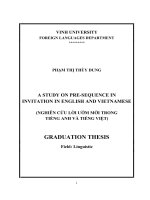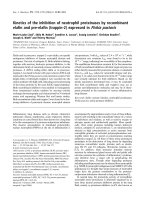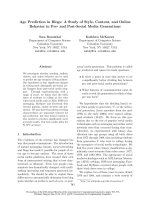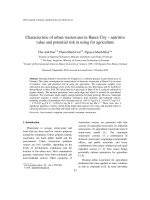Esquisses project and pre text in 19 centurey french cultural
Bạn đang xem bản rút gọn của tài liệu. Xem và tải ngay bản đầy đủ của tài liệu tại đây (15.97 MB, 256 trang )
Free ebooks ==> www.Ebook777.com
www.Ebook777.com
Free ebooks ==> www.Ebook777.com
ESQUISSES/ÉBAUCHES
www.Ebook777.com
PETER LANG
New York y Washington, D.C./Baltimore y Bern
Frankfurt am Main y Berlin y Brussels y Vienna y Oxford
ESQUISSES/ÉBAUCHES
Projects and Pre-Texts in
Nineteenth-Century French Culture
SONYA STEPHENS, EDITOR
PETER LANG
New York y Washington, D.C./Baltimore y Bern
Frankfurt am Main y Berlin y Brussels y Vienna y Oxford
Free ebooks ==> www.Ebook777.com
Library of Congress Cataloging-in-Publication Data
Esquisses/ébauches: projects and pre-texts in nineteenth-century
French culture / edited by Sonya Stephens.
p. cm.
Includes bibliographical references.
1. French literature—19th century—History and criticism. 2. Art, French—
19th century. 3. France—Intellectual life—19th century. 4. Unfinished works of art.
5. Unfinished books. I. Stephens, Sonya.
PQ283.E87 840.9’357—dc22 2005020649
ISBN 978-0-8204-7896-8
Bibliographic information published by Die Deutsche Bibliothek.
Die Deutsche Bibliothek lists this publication in the “Deutsche
Nationalbibliografie”; detailed bibliographic data is available
on the Internet at />
Cover design by Joshua Hanson
Cover art: Paris, a Rainy Day, 1877 (oil on canvas) by Caillebotte, Gustave (1848–94)
©Musee Marmottan, Paris, France/ Giraudon/ The Bridgeman Art Library
Nationality/ copyright status: French/ out of copyright
The paper in this book meets the guidelines for permanence and durability
of the Committee on Production Guidelines for Book Longevity
of the Council of Library Resources.
© 2007 Peter Lang Publishing, Inc., New York
29 Broadway, 18th floor, New York, NY 10006
www.peterlang.com
All rights reserved.
Reprint or reproduction, even partially, in all forms such as microfilm,
xerography, microfiche, microcard, and offset strictly prohibited.
Printed in Germany
www.Ebook777.com
For Robert Lethbridge
CONTENTS
List of Tables................................................................................................................. xi
Foreword...................................................................................................................... xiii
Acknowledgments ..................................................................................................... xvii
SONYA STEPHENS
Introduction ................................................................................................................... 1
MARIANE BURY
Le statut de l’ébauche dans le discours critique au 19e siècle : le cas des
Pensées de Pascal............................................................................................................ 11
WENDELIN GUENTNER
The “Démon de la vitesse”: Technology, Subjectivity and the Sketch............... 23
ISABELLE DAUNAIS
L’œuvre et son avenir : abstraction et révélation de l’image au XIXe siècle....... 32
SONYA STEPHENS
Painting (in) the Studio: Artful Unfinishedness? .................................................... 42
viii
Esquisses/Ebauches
CATHERINE NESCI
Le feuilleton de Delphine de Girardin : poétique et politique du
chiffon .......................................................................................................................... 56
MICHAEL TILBY
« Ainsi l’ébauche vécut…» : du croquis au récit romanesque
au seuil de la Comédie humaine ..................................................................................... 67
JOHN WEST-SOOBY
Débauches en ébauche : la vie marginale de Lamiel ............................................... 81
ANNE GREEN
Sous Napoléon III de Flaubert : ébauches abandonées?........................................... 90
P. M. WETHERILL
Ebauches multiples et contradictoires.................................................................... 102
JACQUES NEEFS
Couper, copier, coller : les dossiers de Bouvard et Pécuchet.................................... 113
TIMOTHY UNWIN
Jules Verne and the History of the Universe ........................................................ 122
ROSEMARY LLOYD
Notes sur quelques carnets de Jules Laforgue ...................................................... 133
RACHAEL LANGFORD
The Political Sketch? Jules Vallès’s Use of the Pictorial in the Jacques
Vingtras Trilogy .......................................................................................................... 143
Free ebooks ==> www.Ebook777.com
Contents
ix
MARY DONALDSON-EVANS
From Ebauche to Débauche: Fleshing out a Baudelairean Sketch
in Maupassant’s Fiction ............................................................................................ 156
DAVID BAGULEY
(D)ébauches zoliennes : les « rogatons » des Rougon-Macquart............................ 168
KATE TUNSTALL
« Une sorte d’idylle dans la Halle » : From ébauche to débauche
in Le Ventre de Paris................................................................................................... 177
JEAN-PIERRE LEDUC-ADINE
Zola, Le Sémaphore de Marseille (17 février 1871–24 mai 1877),
ou un « dossier préparatoire » aux Rougon-Macquart ?........................................... 185
NICHOLAS WHITE
Narrative Closure and the Question of Divorce in
Late-Nineteenth-Century Fiction............................................................................ 200
ROGER PEARSON
« Une inaptitude délicieuse à finir » : Mallarmé and the orthography
of incompletion.......................................................................................................... 211
JOHN HOUSE
Impressionist Painting: esquisse or ébauche? ............................................................. 222
List of Contributors .................................................................................................. 231
www.Ebook777.com
TABLES
Table 1. La famille des Rougon-Macquart : morts et vivants dans
Le Docteur Pascal.......................................................................................................... 170
Table 2. Bilan ............................................................................................................ 170
FOREWORD
These essays were written to honor the achievements of Robert Lethbridge and
to mark his contribution to the profession on the occasion of his retirement. It
is a mark of Robert Lethbridge’s energy, dedication, resourcefulness and sheer
professionalism that he has been able to combine a highly successful career as a
university administrator with his considerable achievements as a scholar. Indeed, as Professor Norman Gowar, former Principal of Royal Holloway, University of London, says, “It is rare for someone's administrative abilities to figure in a celebration of their academic work, but Robert's record as a leader first
in the French Department and then as Vice-Principal is outstanding. His analysis and recommendations always have the same insight, rigour and directness as
his research, and this is undoubtedly recognised by the colleagues he has to
carry with him.” Such is this contribution to administration, teaching and research, and so interrelated are they in Robert Lethbridge’s approach to the profession, that it seems only fitting that this foreword should pay tribute to his
contribution in all three areas.
A strategic thinker in all situations, Robert Lethbridge’s abilities as an administrator have, at every stage of his career, propelled him into strategic positions. In Cambridge, while a Lecturer in French, he became Senior Tutor of
Fitzwilliam College (1982–92), before taking up a Chair in the University of
London in 1994 and the position of Head of Department of French at Royal
Holloway (1995–7). Rosemary Lloyd, recalling the Cambridge years, pays tribute
to “his swift assessment of a problem, an impatience with red tape, and an eagerness to find a resolution” as well as to his “sometimes intimidating wit, his
lapidary assessments of situations, and his earthy good sense.” In these key
roles, Robert Lethbridge was instrumental in radically improving performance
and academic standing, mobilizing, enthusing and supporting his colleagues in
xiv
Esquisses/Ebauches
the process. His success saw him rise to the position of Vice Principal of Royal
Holloway in 1997, a role in which he remained until his retirement in 2003.
Even in retirement, Robert Lethbridge has continued strategically to lead, first
as Director of the University of London Institute in Paris (2003–5) and, most
recently, as Master of Fitzwilliam College, Cambridge.
As a teacher, Robert Lethbridge will be remembered by generations of students as a lecturer capable of provoking spontaneous applause, as a stimulating
reader and interlocutor, generous with both his time and commentary, and as an
intellectually demanding and fearsome critic, “wielding a red pen with a D'Artagnan-like flourish” (Nick White). He is respected and remembered for instilling in his students the importance of a coherent approach and of the kind of
creative and strategic thinking of which he is himself a master, and he will continue to be valued by all those he taught for being a “thought-provoking sparring partner” and for his “willingness to express skepticism at the same time as
encouragement” (Rachael Langford). “Perhaps the secret of his pedagogical
success,” Nick White conjectures, “was that we all took his criticisms as compliments, flattered as we were that he should read even our lowly efforts with
such scrupulous care. And in this, as in much else, he is a paradoxical democrat.”
Alongside these professional commitments, Robert Lethbridge has, for
thirty years and with undiminishing vigor, published a steady flow of editions,
articles and reviews, which have brought him international recognition as one of
the foremost critics of the literature and art of France of the latter half of the
nineteenth century. Almost exclusively within the confines of this period, he has
touched upon the works of a variety of writers such as Bourget, Fromentin,
Mérimée, but it has been mainly on Zola and Maupassant that he has focused
his critical expertise.
For all the refreshing eclecticism of his critical approach, there are definite,
consistent strands in Robert’s work. It began, appropriately, with an apprenticeship to scholarship served through the medium of genetic criticism, which was
much in the spirit of the times and which, most appropriately too, he exercised
on that most allusive of Zola texts, La Curée. Since then, there has been an uninterrupted series of invaluable informative publications, including état present
studies, bibliographies, reception studies and not forgetting (nor disregarding) a
daunting number of incisive book reviews, published particularly in French Studies and The Modern Language Review, peaking at no less than twenty-six in number
in the years 1991–94. In addition, Robert has proven to be a consummate editor
of both volumes of collected essays and translations of novels by Zola and
Maupassant, editions which, without any compromising of density and quality,
reach out effectively to a broader audience, as does his monograph on Pierre et
Foreword
xv
Jean, an object lesson in the art of containing within a succinct format the suggestive analysis of the intricacies of a literary work.
But Robert’s most innovative works comprise an impressive body of critical
interpretations, which follow two definable trajectories. First of all, he has produced a series of enlightening close readings of fictional texts, which explore
with remarkable insight and subtlety the interface between the formal and thematic (and sometimes metafictional) parameters of the texts, tapping into the
very foundations of the “craft of fiction.” Secondly, he has published illuminating analyses of the “artistic relations” between the writer and the painter, between literature and the visual arts, culminating aptly in his recent studies of
L’Oeuvre. Temperamentally more at ease and at his best with the vignette rather
than with the broad fresco, more Maupassant than Zola in this respect, Robert
has composed, nevertheless, an imposing body of criticism, to which this present florilège of studies can only aspire to pay a fitting tribute.
David Baguley and Sonya Stephens
ACKNOWLEDGMENTS
I would like to express my gratitude to those who made possible the intellectual
encounter out of which this volume was born. The British Academy, the Society of Dix-Neuviémistes, the Cultural Delegation of the French Embassy in
London, the Department of French at Royal Holloway, University of London,
and the Royal Holloway itself, all extended financial support which brought the
scholars represented here together in person and in published form.
My own contributions to this volume as well as the early editorial work
were completed during a period of sabbatical leave; I would like to thank Royal
Holloway, University of London for granting me this leave, my colleagues in
French for giving me the opportunity to take it up, and the directors, fellows
and staff of the Humanities Institute at the University of Connecticut where
much of the work was done.
Free ebooks ==> www.Ebook777.com
S
O N Y A
S
T E P H E N S
Introduction
This volume of essays explores pre-texts and projects in nineteenth-century
French cultural production in order to map the coordinates of process in a developing aesthetic of the incomplete. It assembles a cast of international scholars to debate the role of the esquisse (sketch) or ébauche (draft/underpaints) in the
works of key nineteenth-century artists and writers. The corpus is exceptionally
wide-ranging, and the critical approaches are equally diverse, but the focus on a
central question lends cohesion to the collection and draws out the significance
of both a poetics of process and an aesthetic of the unfinished.
Michael Tilby reminds us in the introduction to his essay that, in Le Salon de
1767, Diderot writes: “Les esquisses ont communément un feu que le tableau
n’a pas. C’est le moment de chaleur de l’artiste, la verve pure, sans aucun mélange de l’apprêt que la réflexion met à tout : c’est l’ame [sic] du peintre qui se
répand librement sur la toile.”1 In valorizing in this way the artistic sketch,
Diderot destabilizes an ideal based on balance. It was the beginning of a new
way of conceiving art and henceforth the “ébauche” and the “esquisse” were to
become art forms in their own right. More recently, the art critic Albert Boime
has recognized and documented the emergence of an aesthetic of the sketch in
nineteenth-century French art;2 and similarly, in the textual domain, Jean-François Lyotard—who, in 1985, organized an exhibition entitled (and devoted to)
what he termed “les immatériaux”—asks that we explore “the secret of writing,
the back-and-forth of the text in the process of creating itself, pre-texts, supporting texts, drafts, crossings-out.”3
Art historians have long expressed a (passing) interest in the studies that
prepare the finished work, but the growth of the critical practice devoted to
textual genetics not only confirms an equivalent fascination for everything that
comes before the published text, or what in French is termed the avant-texte, it
also blurs the boundaries, as Michel Contat Denis Hollier and Jacques Neefs
www.Ebook777.com
2
Sonya Stephens
have pointed out, between “hard” and “soft” copy, between public and private
and moves us more resolutely towards the exposure of genesis.4 An aesthetics
of the sketch, or of the ébauche—terms used differently in the visual arts, but
sometimes indiscriminately in the literary field—shifts our attention towards
process and requires that we reflect on the unfinished states in which works are
often presented and develop a poetics of incompletion.
This volume seeks to address these questions and, through a wide-ranging
corpus, proposes ways of thinking about projects and pre-texts in nineteenthcentury France. It is organized according to two main principles (and, to some
extent, in two parts): in the first instance it sets out to establish broadly generic
questions and issues, to foreground debates and expose the fields where we
encounter evidence of an aesthetic of the incomplete; then, as the volume progresses, it offers analyses of major writers and artists who explore this aesthetic.
Mariane Bury examines the status of the “ébauche” in nineteenth-century critical discourse, looking for signs of an interest in an aesthetic, for any attempts to
define the term, and for how the “ébauche” is perceived and understood. Bury,
whilst opening up broad aesthetic questions about critical discourses in this period, focuses on the ways in which Pascal’s Pensées (the ultimate ébauche) is
treated, edited and received in the nineteenth century, for as Paul Bourget argues in 1879: “le Pascal du dix-neuvième siècle est plus encore dans le recueil
mutilé que dans l’œuvre achevée.” Bury takes this example and analyses it in
fine detail to demonstrate that the status of the “draft” manuscript, which is a
priori considered negatively, destroys the status of the book by exploding meaning in order, unexpectedly, to privilege the unfinished, the disorganized and the
imperfect. The “ébauche” thus actualizes a text made contemporary by the
dramatization of an internal debate and goes as far as to make Pascal a Romantic tormented by religious passion and consumed by doubt. In so doing, she
shows the example of the Pensées to be representative of the way in which nineteenth-century critical discourse posits a new conception of literary creation;
one in which the “ébauche” has equal status with the “finished” work; and one
which starts to question the dogma of the great work, perfect and complete.
Wendelin Guentner, in a similar examination of a cultural phenomenon, examines ways in which the increased velocity of life, the “boulimie de vitesse”
wrought by industrialization in nineteenth-century France, notably in transportation, influenced the changing fortune of the sketch. Nineteenth-century art
theorists and critics faithful to the classical tradition accepted the spontaneity
and speed with which preliminary sketches were executed; what they found objectionable on both aesthetic and moral grounds was the fact that many painters
adopted a hasty technique characteristic of the sketch in putatively “finished”
works. For such conservative critics, a work of art demanded time-consuming
study and careful execution, for this would indicate that the superior faculty of
Introduction
3
reason, and the moral qualities of discipline and perseverance, had been called
into play. They decried both the exhibition of the preliminary sketch and paintings where the brush stroke technique suggested rapid execution. By the end of
the century, however, as this volume of essay shows, painters who had apparently employed quick execution—such as Corot, Delacroix, and the Impressionists—were increasingly accepted as great artists. At the same time, some
literary critics contended that during certain historical periods such as their own
writers could only write in a hasty and improvisational manner. Guentner’s
chapter places this change in attitude towards the speed of production in painting and literature into its cultural context by examining eye-witness accounts of
the visually and existentially disorienting experience of train travel and later, of
automobile travel and demonstrates the extent to which, as Clarétie would write
in 1904, “la vie moderne—cette “vie éclaire” […] n’est qu’une collection d’instantanés.” Likewise, Isabelle Daunais, turns to the question of speed, to the
rapidity of gesture and the indetermination that characterizes the spontaneous
to examine the optical phenomenon of revelation. The “ébauche,” Daunais argues, can be seen as a new measure, no longer geometric and spatial as in the
classical period when the subject determined, by his position in space, the precise formulation of objects and forms, but rather temporal and “cinétique.”
From this it follows that the role of the “ébauche” is to occupy a central place,
or rather moment, between apparition and disappearance, between beginning
and end, between virtualities and completions. The “ébauche” is, therefore, in
the situation of not actualizing any fiction, but of powerfully containing all fictions. Its capacity for revelation is due to this in-between status that absorbs
the subject and its position in time and space, to exist only in the speed of observation (or creation). Capturing the world in this moment of speed, making
things and the idea of things accessible outside fiction, thus comes to characterize the work of the subject composing an “ébauche.” Through examples drawn
from descriptions in Naturalist prose writing (Henry Céard, J.-K. Huysmans
and the Goncourt brothers), Daunais demonstrates how “finished” texts reproduce the formal characteristics of the sketch and represent an aesthetic quest
which could be said to constitute an attempt to find the exact speed at which
reality can be captured.
Continuing this pursuit of the phenomena that can be seen, in so many
ways, to frame the debates and practices of the pre-textual and the project,
Sonya Stephens examine the role of the “atelier” in the nineteenth century, seeing it as representative of the erosion (and éclosion) of private space and as symptomatic of the preoccupation with process. Concentrating on representations of
the artist’s studio, she argues that the materiality of process is as present in the
“finish” of the works as it is in the palettes, paintbrushes and other paraphernalia that they portray. Through a range of examples, and with critical emphasis
4
Sonya Stephens
on Courbet’s Atelier du peintre (1855), this essay evaluates the significance of this
relationship between the material surface of the painting/text, its signifier, and
the painterly signifieds for an understanding of an aesthetic of l’oeuvre-se-faisant.
By presenting studios as sites of unfinished process, painters and writers destabilize the socially produced meanings of “finished” work, creating disintegrative
moments and representations that are figured both as failures and potentialities,
and in ways that consistently privilege process over product.
In an entirely different aesthetic category, that of fashion, Catherine Nesci
also explores cultural practices, including fashion chronicles and other ephemera, in her examination of Delphine de Girardin’s feuilleton, “Le Courrier de
Paris” (La Presse, 1836–48). Nesci analyses the way in which Delphine invents a
form of writing to explore the fragmentation of daily life, the “instantanés” and
fleeting insights into “la vie élégante” and erotic feminine mascarade. She places
this analysis of Delphine in the wider context of nineteenth-century writers’
fascination for the anecdotal, the fait-divers, the expression of social conduct and
cultural practice in an ever-growing daily press, with its limitless reserves of clichés et chatter, its cult of the ephemeral and its desire to “colonize” its readership with, on the one hand, surprise and sensationalism and, on the other, the
construction of a familiar, recognizable and desirable space.
At about the same time (1830 onwards) Balzac was developing an interest in
the graphic arts, frequenting artists and painters and beginning to contribute to
journals such as La Caricature and La Silhouette, journals which owe a great deal
to the aesthetics of the sketch. As Michael Tilby shows, however, Balzac’s attitude towards the “esquisse” or “ébauche” is fundamentally ambiguous: Januslike, the non finito can be both imperfect execution and creative suggestion, so
that Balzac sometimes writes of “grossières ébauches,” sometimes of the “sublimes ébauches de nos premiers artistes”; “esquisses” are frequently “informes,”
or give only “une faible idée” until translated by the paintbrush. Tilby’s argument focuses on the passage from “ébauche” to completed text in a number of
key narratives; on the way in which Balzac’s writing develops from the spontaneous and the anecdotal; and on the way in which he develops the “ébauche” in
order to engage in more creative “réécriture.” In this regard, Tilby examines the
relationship between “Le Dernier Napoléon” and the episode in La Peau de chagrin which “explodes” the earlier croquis and raises discursive questions which go
to the very heart of Balzac’s creative method and illuminate that very Balzacian
tension between contraction and expansion. In similar vein, John West-Sooby
considers Stendhal’s late years (1839 onwards) and the accumulation of unfinished projects which he sees in sharp contrast to the monumental Chartreuse de
Parme brought to completion in that year. West-Sooby presents the case of the
dossiers préparatoires for Lamiel which, he argues, show the work in motion as a
kind of laboratory of novelistic creation in which “texte” and “hors-texte” are
Introduction
5
locked in perpetual dialogue, sometimes fertile, sometimes completely unproductive. Lamiel, Westy-Sooby shows, lives more in the margins than it does in
the editions of the text, however varied these editions might be. Preferring to
see the notes less as marginal annotations than as material described as limitrophe, John West-Sooby presents the textual edges as a nourishing, centripetal
force. As he tracks the developments in the manuscript, we see a layering of
projects, each with different aspirations which, in their turn, marginalize the
protagonist: she is, West-Sooby explains, “débauchée,” in both senses of the
word and her disintegration coincides with the disintegration of the project itself.
Continuing with an interrogation of novelistic preparations, Anne Green examines Flaubert’s notes and plans for Sous Napoléon III. Soon after the end of
the Second Empire, Flaubert began to jot down ideas for a novel with this provisional title. Compiled over a period of seven years or so, these preparatory
dossiers show Flaubert struggling to formulate his ideas about the period and to
find a suitable form in which to express them. Anne Green’s chapter brings into
sharp focus the unresolved tensions between the projected novel’s form and its
often scandalous content, as well as drawing our attention to the shifting structures with which Flaubert tried to pin down an increasingly elusive subject before finally abandoning the project. Remaining with Flaubert and his manuscripts, both Michael Wetherill and Jacques Neefs consider the instability of the
text and its incompletions. Michael Wetherill, whilst concentrating on L’Éducation sentimentale, proposes a way of reading all Flaubertian (and potentially
other) pre-texts as textual multiplication, as a series of autonomous “states” or
concurrent versions, rather than as a single evolving version (the one that will
eventually be published). We can and should, Wetherill argues, examine these
texts as independent entities leading to varied, sometimes even radically different, readings of the novel we think we know. Jacques Neefs examines the vertiginously specular form of the novel Bouvard et Pécuchet of which Flaubert wrote:
“Il faut que la page s’emplisse, que le ‘monument’ se complète.” Neefs sees in
Bouvard et Pécuchet a neverending story through the copyist activities of the two
protagonists, a non finito which finds a projection in the work of Flaubert himself. Neefs also argues that that part of unfinishedness brought about by the
author’s death is essential to the work and its profound critical dimension (it is a
critique of knowledge, of power and a comedy of ideas). Neefs analyses the
“cutting and pasting” in the dossiers préparatoires in order to expose the political
and epistemological enterprise that the novel represents.
Bouvard and Pécuchet aim, then, at a monumental, encyclopaedic completion. Similarly, one might say that a leitmotif of Jules Verne’s writing is, in the
Voyages Extraordinaires, an attempt to tell the “history of the universe.” This colossal ambition is the central impulse behind the vast corpus of novels written
6
Sonya Stephens
by Jules Verne between the mid-1860s to 1905. As Balzac had already discovered in a similar wager with the impossible, the larger the novelist’s canvas becomes, the more gaps there are to be bridged. Timothy Unwin argues that the
Voyages Extraordinaires offer us the spectacle of a work that is both astonishingly
complete and hopelessly fragmentary. Examining the co-existence of the fragmented and the complete, Unwin both exposes the very significant scientific
and geographical coverage that Verne offers in his representation of the nineteenth-century world, whilst arguing that the author’s totalizing enterprise is
predicated on the repetition of a number of well-tried procedures and formulae, recyclings and rewritings. Unwin argues here that to read the Voyages Extraordinaires in extenso is to witness extraordinary energy and vitality, to gauge
the power of renewal and reinvention sustained over four decades and, while it
is certainly not the history of the universe, that energy betokens a constant
reaching upwards and outwards towards an unattainable, unfinishable, ideal.
Jules Laforgue (1860–1888), though he has quite different aspirations from
Verne, participates in the same reaching out for the unattainable, or for a kind
of infini. One of his carnets opens with the statement: “Négliger les chefsd’œuvre finis—et analyser intimement les pochades.” The idea of finish, of
perfection, repulsed this poet who understood perhaps better than any writer
that the representation of the modern world is better accomplished through the
sketch rather than the polished work, that the draft is more suggestive than the
final version. Rosemary Lloyd here examines Laforgue’s brouillons, his notes or
what he himself calls “notules,” and argues that in both his writings and the
drawings of the carnets, he exposes a predilection and a deep understanding of
an aesthetic of the non finito. Lloyd questions the role of such notations in the
wider writings and formal experimentations of Laforgue and sees in them the
same aesthetic of the sketch and the unfinished that characterize his use of the
“vers libre” and his associative word play. These, she argues, open new creative
horizons and invite the reader to create logical connections and relationships
between impossible couplings: couplings which, for Laforgue represent “le
charme insoluble, obsédant, entêtant des antinomies en métaphysique, une parenthèse,—infinie—et qui s’ouvre—et pour l’éternel malheur.”
With a quite different purpose in mind, the politically engaged writings of
Jules Vallès’ Jacques Vingtras trilogy demonstrate the same “sketchiness” and an
unusual use of the graphic. Rachael Langford explores the way that these texts
make full use of the blank space and the physical boundaries of the page, of
typographical resources and, in specific instance, of pictograms. She argues, too,
that the use of ellipsis calls on the reader to supply missing words or, more
radically, to imagine whole scenes or exchanges which are elided behind the
text’s “points de suspension.” Rachael Langford’s study of Vallès’ graphic practices examines the extent to which these are able to convey the contestatory and









